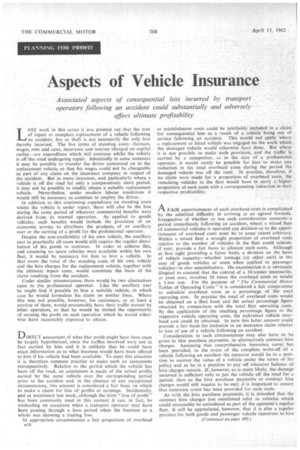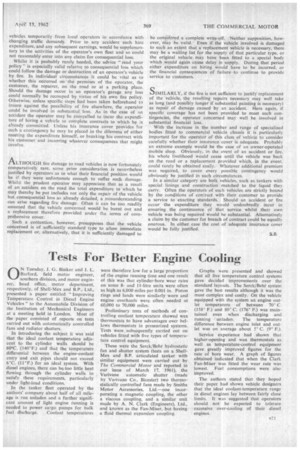Aspects of Vehicle Insurance
Page 76

Page 79

If you've noticed an error in this article please click here to report it so we can fix it.
Associated aspects of consequential loss incurred by transport operators following an accident could substantially and adversely affect ultimate profitability
L.
AST week in this series it was pointed out that the cost of repair or complete replacement of a vehicle following an accident, fire or theft is not necessarily the only loss thereby incurred. The five items of standing costs—licences, wages, rent and rates, insurance and interest charged on capital outlay—are expenditure which will continue whilst the vehicle is off the road undergoing repair. Admittedly in some instances it may be possible to transfer the driver concerned on to the replacement vehicle so that his wages could not be chargeable as part of any claim on the insurance company in respect of the accident. But in many instances, and particularly where a • vehiele is off the road for only a comparatively short period. it may not be possible to readily obtain a suitable replacement vehicle. Nevertheless, under modern labour conditions it would still be necessary to continue to employ the driver.
In addition to this continuing expenditure on standing costs whilst the vehicle is under repair, there will also be the loss during the same period of whatever commercial benefits were derived from its normal operation. As applied to goods vehicles, such benefits would include the provision of an economic service to distribute the products of an ancillary user or the earning of a profit for the professional operator.
Despite the non-availability of his own vehicle, the ancillary user in practically all cases would still require the regular distribution of his goods to continue. in order to achieve this, and assuming no spare vehicles were available within his own fleet, it would be necessary for him to hire a vehicle. In that event the total of the standing costs of his own vehicle and the hire charges for the replacement vehicle, together with the ultimate repair costs, would constitute the basis of his claim resulting from the accident.
Under similar circumstances there would be two alternatives open to the professional operator. Like the ancillary user he might find it possible to hire a suitable vehicle, in which case he would formulate his claim on similar lines. Where this was not possible, however, his customers, or at least a portion of them, would presumably have their traffic moved by other operators, so that he would be denied the opportunity of earning the profit on such operation Which he would otherwise have reasonably expected to obtain.
DIRECT assessment of what that profit might have been must be largely hypothetical, since the traffics involved were not in fact carried by him and it is unlikely that he could have exact information as to what business would have been offered to him if his vehicle had been available. To meet this situation it is therefore common practice to make such an assessment retrospectively. Relative to the period which the vehicle has been off the road, an assessment is made of the actual profits earned by the same vehicle over the corresponding period prior to the accident and, in the absence of any exceptional circumstances, this amount is considered a fair basis on which
• to make a claim for loss of profits or earnings. Incidentally, and as mentioned last week, although the term " loss of profit" has been commonly used in this context it can, in fact, be misleading on occasions when a transport operator may have been passing through a lean period when the business as a whole was showing a trading loss.
In appropriate circumstances a fair proportion of overhead RI 8
or establishment costs could be justifiably included in a claim for consequential loss as a. result of a vehicle being out of service following, an accident. This would not apply where a replacement or hired vehicle was engaged on the work which the damaged vehicle would otherwise have done. But where it is not possible to make such provision, and the traffic iscarried by a competitor, as in the case of a professional operator, it would rarely be possible for him to make -any reduction in his total overhead costs during the period the damaged vehicle was off the road. In practice, therefore, if no claim were made for a proportion of overhead costs, the remaining vehicles in the fleet would have to carry a higher proportion of such costs with a corresponding reduction in. their respective profitability.
AFAIR apportionment of such overhead costs is complicated by the admitted difficulty in arriving. at an agreed formula. Irrespective of whether or not such consideration concerns 'a period immediately following an accident, where a mixed fleet of commercial vehicles is operated any decision as to the apportionment of overhead' costs must be to some extent arbitrary. Within a mixed fleet a straight proportion of overhead costs relative to the number of vehicles in the fleet could seldom, if ever, provide a fair basis to allocate such costs. Although at first sight providing a fairer basis, a division on the basis of vehicle capacity—whether tonnage .(or other unit) in the case of goods vehicles or seats when applied to passenger vehicles—is also unsatisfactory. On examination it is obviously illogical to contend that the control of a 10-tonner necessarily, or even ever, involves 10 times the overhead costs as would a 1-ton van. For the purpose of " The Commercial Motor Tables of Operating Costs" it is considered a fair compromise to calculate overhead costs as a percentage of the total operating cost. In practice the total of overhead costs would be obtained on a fleet basis and the actual percentage figure obtained by comparison with the total fleet operating costs. By the application of the resulting percentage figure to the respective vehicle operating costs, the individual vehicle overhead cost could be obtained. In turn this latter amount could provide a fair basis for inclusion in an insurance claim relative to loss of use of a vehicle following an accident.
Consideration in such circumstances may also have to be given to hire purchase payments, or alternatively contract hire charges. Assuming that comprehensive insurance cover has been provided, in the event of the complete write-off of a vehicle following an accident the operator would be in a position to recover the value of a vehicle under the terms of his policy and so be in a position to pay off whatever balance of hire charges remain. If, however, as is more likely, the damage incurred is sufficient only to put the vehicle off the road for a period, then as the hire purchase payments or contract hire charges would still require to be met, it is important to ensure that insurance cover has been provided for such costs.
As with the hire purchase payments, it is intended that the contract hire charges just mentioned refer to vehicles which could reasonably be considered as part of the operator's regular fleet. It will be appreciated, however, that it is also a regular practice for both goods and passenger vehicle operators to hire
vehicles temporarily from local operators in accordance with changing traffic demands. Prior to any accident such hire expenditure, and any subsequent earnings, would be supplementary to the activities of the operator's own fleet and so could not reasonably enter into any claim for consequential loss.
Whilst it is probably rarely heeded, the advice "read your policy" is especially valid relative to consequential loss which could follow the damage or destruction of an operator's vehicle by fire. In individual circumstances it could be vital as to whether this occurred on •the premises of the operator, the customer, the repairer, on the road hr at a parking place. Should the damage occur in an operator's garage any loss could normally be recouped by virtue of his own fire policy. Otherwise, unless specific steps had been taken beforehand to insure against the possibility of fire elsewhere, the operator could be involved in substantial loss, As in the case of an accident the operator may be campelled to incur the expenditure of hiring a vehicle to complete contracts to which he is already committed. Unless his insurance cover provides for such a contingency he may be placed in the dilemma of either meeting the expenditure himself, or breaking his contract with his customer and incurring whatever consequences that might involve.
ALTHOUG H fire damage to road vehicles is now fortunately comparatively rare, some prior consideration is nevertheless justified by operators as to what their financial position would be if they were unfortunate enough to suffer such damage. Whilst the prudent operator may appreciate that as a result of an accident on the road the total expenditure to which he may thereby be put includes not only the repair of the vehicle but consequential loss as already detailed, a misunderstanding can arise regarding fire damage. Often it can be too readily assumed that the vehicle concerned would be burnt out and a replacement therefore provided under the terms of comprehensive cover.
Such a contention, however, presupposes that the vehicle concerned is of sufficiently standard type to allow immediate replacement or, alternatively, that it is sufficiently damaged to be considered a complete write-off. Neither supposition, however, May be valid. Even if the vehicle involved is damaged to such an extent that a replacement vehicle is necessary, there may be a waiting list for the supply of that particular type, or the original vehicle may have been fitted to a special body which would again cause delay in supply. During that period either expenditure on hiring would have to be incurred, or the financial consequences of failure to continue to provide service to customers.
SIMILARLY, if the fire is not sufficient to justify replacement of the vehicle, the resulting repairs necessary may well take as long (and possibly longer if substantial painting is necessary) as repair of damage caused by an accident. Here again, if specific coverage has not been provided to meet such contingencies, the operator concerned may well be involved in substantial financial loss.
With the increase in the number and range of specialized bodies fatted to commercial vehicle chassis it is particularly important for the operator of this class of vehicle to consider carefully whether their insurance cover is adequate. Probably an extreme example would be the case of an owner-operated mobile shop. Obviously, in the event of an accident or fire, his whole livelihood would cease until the vehicle was back on the road or a replacement provided which, in the event. could rarely be obtained easily. Whatever additional premium was required, to cover every possible contingency would obviously be justified in such circumstances.
In a similar category are bulk vehicles, such as tankers with special linings and construction matched to the liquid they carry. Often the operators of such vehicles are strictly bound by the conditions of contract with their customer to provide a service to exacting standards. Should an accident or fire occur the expenditure they would undoubtedly incur in ensuring the continuance of that service whilst their own vehicle was being repaired would be substantial. Alternatively a claim by the customer for breach of contract could be equally onerous. In either case the cost of adequate insurance cover would be fully justified.




















































































































